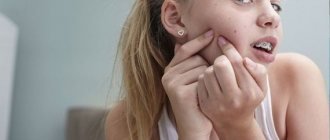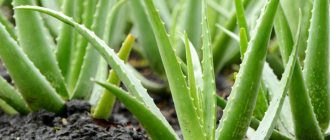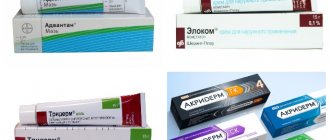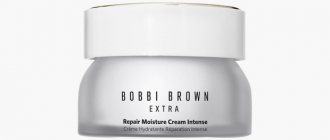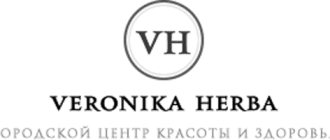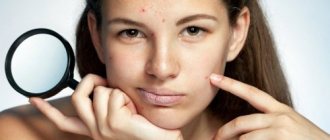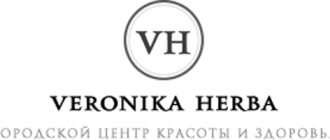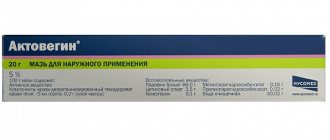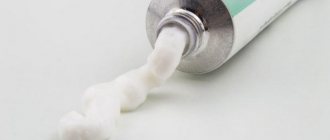Cosmetologist YULIANA SHIYAN: Acne in a teenager is considered common, although any diagnosis, including “simple acne,” should not be considered the norm. Moreover, the calm attitude of adults towards a rash on a teenager’s face does not make life easier for the child; this does not make his self-esteem higher, nor does his anxiety decrease. And if you notice that the child once again does not go out with friends and stays at home at every opportunity, then pay attention to this; this is hardly a normal desire to do homework.
For acne in teenagers, a variety of remedies are used:
- Azelaic acid
- Antibiotics, external and systemic, for example erythromycin, clindamycin
- Zinc preparations (internally and externally)
- Benzoyl peroxide
- Retinoids (internally and externally)
There is now a lot of information in the public domain about how to get rid of acne for a teenager. Buying ointment at a pharmacy is not a problem at all; advertisements for all kinds of zinerites and basirons are a dime a dozen. The main thing for parents in this flow of information and availability of medications is not to slip into self-medication.
Each of the drugs listed is good, and it seems that now we’ll buy it, apply it and we’ll have clear skin. But in fact, each drug has many nuances in use, for pustules one, for blockages another, for irritated skin a third. Most of them require supplementation for strengthening or reinsurance so that resistance (stability) of the flora does not form.
They have a side effect that is either considered normal or requires immediate cancellation. When and how to add oral medications to external treatment, and whether acne is purely teenage acne or requires additional specialists are separate questions. It is impossible to determine all this on your own and there is simply no knowledge. Therefore, you need to contact me and sign up for a consultation.
Causes of acne in children and adolescents
Pimples occur when pores become clogged. What type of acne occurs depends on what is clogging the pores. Although scientists are still trying to figure out why some people's skin is more prone to developing acne, it's likely that hormones play a role. This explains why acne is so common among teenagers.
During puberty, hormones called androgens increase the size of the skin's oil glands. These glands begin to produce more sebum, which can clog your pores.
But acne can start before (or after) adolescence. About 20% of newborns suffer from neonatal acne, which usually appears between the second and fourth weeks of life. This type of acne goes away on its own without leaving any scars. It also does not increase the risk of developing severe acne later in life.
Some children develop infantile acne, which appears between 3 and 6 months of age. Baby acne can cause deep nodules and cysts, leading to permanent acne scarring. Fortunately, childhood acne is rare. Source: Modern concept of the etiopathogenesis of acne vulgaris. Isaeva M.S., Burieva Z.T. Avicenna Bulletin, 2010. p. 127-132 Pathogenetic approaches to the treatment of acne vulgaris. Khaldin A.A., Mareeva E.B., Skvortsova A.I. Russian Journal of Skin and Venereal Diseases, 2012. p. 34-37.
How to avoid blackheads on your nose
When comedones occur, teenagers begin to actively look for methods to combat them. Many even try to find out in medical reference books what to do if there are blackheads on the nose, how to remove them? And this struggle often takes a lot of money and a lot of time.
It is much easier to prevent this “disease”. To do this, you should pay attention to certain things:
- Review your diet by eliminating fatty, fried and sweet foods.
- Wash your face 2 times a day using toilet soap.
- Use a scrub 2 times a week to remove dead epithelium.
- Use hypoallergenic, oil-free cosmetics.
- Limit touching your face, especially with dirty hands.
You should carefully monitor the cleanliness of gadgets, bedding and other items that often come into contact with your facial skin.
What causes acne and what causes it
While stress may not cause acne, it can make existing acne worse. Research shows that when stress increases, the severity of acne increases. Acne may get worse if teens:
- sleep too little;
- eat certain foods traditional to the Western diet;
- use oily cosmetics and skin care products.
Almost everyone experiences at least a few breakouts during their teenage years. It is impossible to predict who will develop more severe acne, but there is an increased risk if one or both parents (or other close blood relatives) have had severe acne that results in scarring.
Types of acne, formation mechanism and what they look like
Teenage acne on the face of adolescents can be of several types (or a combination of them). Source: Pathogenetic rationale for local acne therapy in adolescence. Mazitova L.P., Aslamazyan L.K., Kvachakhiya L.L., Namazova L.S. Pediatric pharmacology, 2008. pp. 94-97):
- whiteheads;
- black dots;
- acne;
- nodules, cysts, or both (deep and painful).
- Whiteheads . Removing whiteheads can lead to more whiteheads and acne scars, which is why dermatologists recommend treating whiteheads with an acne treatment rather than picking at them. Whiteheads form when excess oil and dead skin cells clog the pores. This causes white or flesh-colored pimples to appear. Medical name: closed comedon, which means “closed pore.”
- Black dots . Dermatologists recommend treating this type of acne with a retinoid, since squeezing the blackheads can cause infection or permanent scarring. This type of acne also develops when excess sebum and dead skin cells accumulate inside the pore. As the secretion accumulates, it expands the pores and you see blackheads. Many people mistakenly believe that a black spot is dirt. What you are actually seeing is a chemical reaction. When deposits inside the pore react with oxygen in the air, a black color appears. Medical name: open comedo, which means “open pore.”
- Sometimes excess oil, dead skin cells and bacteria get trapped in the pores. Bacteria, which are usually found on our skin, can multiply quickly in excess oil. As the pores become filled with bacteria, inflammation (swelling) develops and a pimple appears. Medical name: If a pimple contains pus, it is called a pustule . A pimple without pus is called a papule .
- Nodule or cyst . When the pores become filled with excess oil, dead skin cells and bacteria, causing inflammation (swelling) that penetrates deep into the skin, a lump or cyst forms. Because these rashes penetrate deep into the skin, they can be painful. The main difference between a nodule and a cyst is that the cyst contains pus. Because nodules do not contain pus, they feel firmer to the touch than cysts.
Non-standard means
To clean your nose from blackheads, you can use non-standard products that are not very popular. But the components for creating the mixture are always at hand.
We offer you 2 non-standard but effective recipes. One will tell you how to remove blackheads from your nose with toothpaste:
- First you need to choose the right toothpaste. A high-quality one should contain soda and components of medicinal herbs. With its help we will make a scrub mask.
- Mix 5 g of soda with the described toothpaste until a paste-like mass is formed.
- Apply it to problem areas and leave there for 10 minutes.
- After time has passed, remove the scrub using a damp cotton pad.
- Residues should be washed off with liquid soap and water. And immediately after the procedure, use a moisturizer.
Another recipe suggests using soda to remove blackheads on the nose. But in this case, you should remember that you can use it only if there are no injuries to the skin around the nose.
- Make a paste mixture of baking soda and salt in a 1:1 ratio. Add water until you get a soft paste.
- Wash off makeup from your face and moisturize it by washing with water at room temperature.
- Place a small amount of the mixture on a cotton pad.
- Apply the finished product in a circular motion, without trying to rub it into the skin too much.
- The procedure should last about 3 minutes, after which the product is washed off with warm water without soap.
- Give your skin a little rest and apply a mild moisturizer.
Consequences of acne
Acne can cause more than just rashes. Some people believe that acne is a skin condition that eventually outgrows, but it can have a profound and lasting impact on one's life. Many people experience one or more of the following after acne appears.
Acne scars: When the breakout goes away, it leaves behind a permanent scar. Some scars cause indentations in the skin. The rest are gradually disappearing. It's impossible to predict who will develop scars after their acne goes away, but the following factors increase your risk:
- acne has been present for a long time because the teenager does not treat it or the treatment does not work;
- One or more close blood relatives have had acne in the family.
Dark spots on the skin: As acne breakouts fade, some people see the area where acne once was. This completely flat spot can be pink, red, purple, black or brown, and is often mistaken for a permanent acne scar. Source: Modern Treatments and Rehabilitation of Acne Vulgaris. Barinova A.N. Russian family doctor, 2022. p. 5-18.
Proper nutrition
Skin largely reflects our lifestyle. When you abuse fried and fatty foods, toxins enter the bloodstream and negatively affect the condition of tissues. Doctors recommend sticking to a healthy diet, consuming enough proteins, complex carbohydrates and fiber. The latter ensures normal functioning of the gastrointestinal tract and prevents the formation of constipation, which also has a positive effect on skin health.
If possible, you should avoid smoked meats, mayonnaise, chocolate, and processed foods. Both the abundance of flour products and excessive consumption of sugar have a negative impact on the appearance. Often, restrictions on sweets give quick and visible results.
Diagnostics
If your teen has acne, a dermatologist can diagnose acne by looking at the breakouts. During your appointment, your dermatologist will also note what types of acne they are and where the breakouts appear on the skin. This will help your dermatologist create an effective treatment plan. Sometimes what looks like pimples is another problem. For example, some people mistake hidradenitis suppurativa, also called acneinversa, for everyday acne. Treatment for this condition is different from that for acne. Another disease that can be mistaken for acne is perioral dermatitis. This often causes rashes that look like pimples around the mouth. Whether your teen has stubborn acne or another condition, a dermatologist can accurately diagnose acne vulgaris and create a treatment plan tailored to your teen's needs.
Treatment of facial acne in teenagers
The appropriate acne treatment plan depends on many factors, including:
- type of acne;
- where acne appears on the skin;
- what treatments have already been tried;
- when the rash started;
- age;
- whether acne left dark spots or scars Source: Modern methods of treating acne in children. Nosacheva O.A., Torshkhoeva R.M., Namazova-Baranova L.S. Pediatric pharmacology, 2013. p. 23-30.
Your treatment plan may vary. But there are a number of drugs that are included in clinical guidelines for the treatment of acne. Effective treatment for facial acne in a teen may include retinoid medications, benzoyl peroxide, azelaic acid, or salicylic acid. An antibiotic may be prescribed and applied to the skin.
Nodules and cysts are more difficult to treat. Treatment may consist of prescription medications applied to the skin, antibiotics, and isotretinoin (a medication approved for the treatment of severe acne).
Sometimes additional laser or light therapy is needed: Research shows that laser and light devices can help clear up acne. This type of treatment works best in combination with other acne treatments.
Healthy Diet: Some studies show that eating a healthy diet can also help give you clearer skin.
Skin care is so important that without it you won't get the results you want. Even if you use an acne treatment correctly, if teens are too rough on their skin, new breakouts may appearSource: Combination Acne Therapy. Mamarasulov D.I., Yuldashev M.A., Moon A.V., Ismoilov B.B. Medicine: theory and practice, 2019. p. 342-343.
Prevention
Do not wash your face with soap or use rough scrubs too often. Acne is not caused by dirt. Two gentle washes a day are enough. Exfoliating your skin too often can cause irritation and dryness of the skin, which causes the glands to produce more oil, which increases the likelihood of acne.
Use non-comedogenic products (those that do not clog pores) on your face.
Do not press on the spots, as this can drive bacteria deeper into the skin. This can lead to more inflammation and permanent scarring.
Sources:
- Modern concept of etiopathogenesis of acne vulgaris. Isaeva M.S., Burieva Z.T. Avicenna Bulletin, 2010. p. 127-132
- Pathogenetic approaches to the treatment of acne vulgaris. Khaldin A.A., Mareeva E.B., Skvortsova A.I. Russian Journal of Skin and Venereal Diseases, 2012. p. 34-37
- Modern methods of treatment and rehabilitation of patients with acne vulgaris. Barinova A.N. Russian family doctor, 2022. p. 5-18
- Pathogenetic rationale for local therapy for acne in adolescence. Mazitova L.P., Aslamazyan L.K., Kvachakhiya L.L., Namazova L.S. Pediatric pharmacology, 2008. p. 94-97
- Modern methods of treating acne in children. Nosacheva O.A., Torshkhoeva R.M., Namazova-Baranova L.S. Pediatric pharmacology, 2013. p. 23-30
- Combination therapy for acne. Mamarasulov D.I., Yuldashev M.A., Moon A.V., Ismoilov B.B. Medicine: theory and practice, 2022. p. 342-343
The information in this article is provided for reference purposes and does not replace advice from a qualified professional. Don't self-medicate! At the first signs of illness, you should consult a doctor.
Cosmetic procedures
To look attractive and restore healthy skin, you need to find the root cause of blackheads. A doctor who deals with skin diseases is called a dermatologist. You may need to visit an endocrinologist, gynecologist and gastroenterologist.
Special cosmetic procedures help effectively remove blackheads. They can be used as an independent method of treatment or as a method that complements the main therapy.
People with problem skin first try to squeeze out comedones on their own. But it is better to consult a cosmetologist. This procedure in professional language is called mechanical cleaning. The face is first steamed, spots are removed with special tools, after which anti-inflammatory and pore-narrowing agents are applied.
In beauty salons, comedones are removed using phototherapy. The procedure is so called because of the use of short flashes of light that destroy pathogenic bacteria and regulate the functioning of the sebaceous glands. Phototherapy removes spots on the face, as well as freckles on the nose and rosacea on the cheeks in a course of 5-7 procedures.
Chemical peeling also helps get rid of comedones. To carry it out, substances are used that soften the horny scales and help open the skin pores. After application and light rubbing, you can reduce greasiness and get rid of rashes.
You can remove spots on your face using the biodermabrasion procedure. For it, several types of peeling are taken, which prepares the epidermis for mechanical stress. Biodermabrasion removes superficial and deep blackheads, relieves inflammation and oily skin.
Prices
| Name of service (price list incomplete) | Price |
| Appointment (examination, consultation) with a dermatovenerologist, primary, therapeutic and diagnostic, outpatient | 1950 rub. |
| Consultation (interpretation) with analyzes from third parties | 2250 rub. |
| Prescription of treatment regimen (for up to 1 month) | 1800 rub. |
| Prescription of treatment regimen (for a period of 1 month) | 2700 rub. |
| Consultation with a candidate of medical sciences | 2500 rub. |
| Dermatoscopy 1 element | 700 rub. |
| Setting up functional tests | 190 rub. |
| Excision/removal of cutaneous/subcutaneous elements and formations (1 element) | 2550 rub. |
| Removal of milia of one unit using electrocoagulation | 350 rub. |
